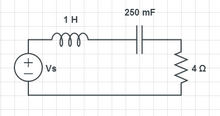Circuit Theory/Convolution Integral/Examples/example49/current

Given that the source voltage is (2t-3t2), find voltage across the resistor.
Here focused on finding current first:
Transfer Function
[edit | edit source]simplify(1/(4 + s + 1/(0.25*s)))
Homogeneous Solution
[edit | edit source]solve(s^2 + 4.0*s + 4.0,s)
There are two equal roots at s = -2, so the solution has the form:
Particular Solution
[edit | edit source]After a long time attached to a unit step function source, the inductor has shorted and the capacitor has opened. All the drop is across the capacitor. The current is zero.
Initial Conditions
[edit | edit source]So far the full equation is:
Initial current through the series leg is zero because of the assumed initial conditions of the inductor. This means:
Assuming the initial voltage across the capacitor is zero, then initial voltage drop has to be across the inductor.
After a long period of time, the current still has to be zero so:
This means that:
The 4 is lost in the numerator of the transfer function if a transfer function is written for Vr initially. The 4 does not make it into the homogeneous solution. In second order analysis, never write a transfer function for a resistor.
Impulse Solution
[edit | edit source]Taking the derivative of the above get:
Convolution Integral
[edit | edit source]f := (4*exp(-2*(t-x)) - 8*(t-x)exp(-2*(t-x)))*(2*x-3*x^2); S :=int(f,x=0..t)
There will not be any constant since again, V_R(t) = 0 after a long time ... and the capacitor opens.
















